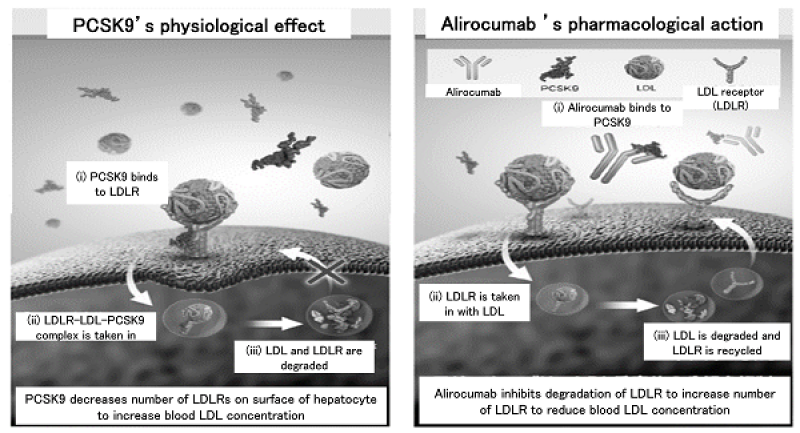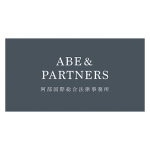
(Praluent IF, page 78)
Summary of the case
Amgen manufactured and sold PCSK9 inhibitor Repatha whereas Sanofi manufactured and sold PCSK9 inhibitor Praluent, for the treatment of hyperlipidemia. In 2019, Repatha enjoyed a 70% share of the PCSK9 inhibitor market whereas Praluent enjoyed 30%.
Amgen owns two patent rights, JP5705288 and JP5906333, entitled "Antigen-binding protein against proprotein convertase subtilisin kexin type 9 (PCSK9)".
Claim 1 of JP5705288 is as follows:
An isolated monoclonal antibody, wherein the monoclonal antibody can neutralise binding of PCSK 9 to LDLR protein, and competes for binding to PCSK9 with an antibody including a heavy chain, including CDR 1, 2 and 3 consisting of an amino acid sequence in SEQ ID NO: 368, 175 and 180, respectively and a light chain including CDR 1, 2 and 3 consisting of SEQ ID NO: 158, 162 and 395, respectively.
The claim 1 of JP5705288 after the correction is as follows:
An isolated monoclonal antibody, wherein the monoclonal antibody can neutralise binding of PCSK 9 to LDLR protein, and competes for binding to PCSK9 with an antibody including a heavy chain, including a heavy chain variable region consisting of an amino acid sequence in SEQ ID NO: 49 and a light chain, including a light chain variable region consisting of an amino acid sequence in SEQ ID NO: 23.
Amgen sought an injunction etc. against Sanofi regarding the manufacture, sale, import, and offer to sell of Praluent and Alirocumab by Sanofi. Sanofi filed a request for a trial for invalidation of Amgen’s two patents.
Judgment of October 30 2019, the IP High Court
The Tokyo District Court (Presiding Judge Shibata) ordered an injunction against Sanofi regarding the manufacture, sale, import, and offer to sell of Praluent and Alirocumab and a disposal of Praluent, stating that Praluent and Alirocumab fall within the technical scopes of the inventions 1 and 2 (the respective inventions described in claims 1 of JP5705288 and JP5906333) and corrected inventions 1 and 2 (the respective inventions described in corrected claims 1 of JP5705288 and JP5906333), and none of the reasons for invalidation stated by Sanofi have any substance. Sanofi appealed to the IP High Court, where the court (Presiding Judge Takabe) dismissed Sanofi’s appeal, stating as follows. A holding regarding inventive step was omitted.
(1) Whether it falls within the technical scope of the invention
Sanofi alleges that each of the inventions is a functional claim that specifies the invention only by a function to compete with reference antibody 1 or 2 (specified antibody in claims 1 of JP5705288 and JP5906333), and when it comes to a functional claim, the technical scope of the invention should be defined on the basis of the technical idea shown in specific configurations that the applicant disclosed in the specification, by taking into account the specification in addition to the claims. Thus a functional claim should be narrowly construed to have a scope within which a person ordinarily skilled in the art can perform from the specification. Further, Sanofi alleges that a scope where a person ordinarily skilled in the art can perform from the specification is limited to specific antibodies described in the examples of each of the specifications or antibodies having an amino acid sequence in which one or several amino acids at a specific position are substituted in the former antibody. Thus the technical scope of each of the inventions is limited to each of the above antibodies or amino acid sequences in which one or several amino acids at a specific position are substituted in the antibody. As Praluent and Alirocumab have a different amino acid sequence from them respectively, they do not fall within the technical scope of each of the inventions.
Setting aside the question of whether each of the inventions should be called a so-called “functional claim”, the technical scope of the patent invention must be determined on the basis of the claims, and should be construed on the basis of a technical idea disclosed therein by taking the specification and drawings into account. Sanofi’s allegation should be considered as a problem concerning the support requirement or enablement requirement. Further, it cannot be said that there is a description in each of the specifications indicating that each of the inventions is specified only by a function to compete with reference antibody 1 or 2. Sanofi's allegation of each of the inventions being limited to the examples on the premise of that is not acceptable. Moreover, each of the inventions is not specified by an amino acid sequence. Thus there is no reason to construe them as being limited to specific antibodies described in each of the specifications or antibodies having an amino acid sequence in which one or several amino acids are substituted at a specific position in the former antibodies.
(2) Support requirement
A person ordinarily skilled in the art can obtain an isolated monoclonal antibody that neutralises the binding of PCSK9 and LDLR protein and competes with reference antibody 1 or 2 on the basis of each of the specifications. Thus, novel antibodies of monoclonal antibodies of inventions 1-1 and 2-1are provided. Further, one can recognise the fact that a pharmaceutical composition of inventions 1-2 and 2-2 (the respective inventions described in claim 9 of JP5705288 and in claim 5 of JP5906333) using above monoclonal antibodies may treat or prevent or reduce the risk of the diseases associated with increased cholesterol level such as hypercholesteremia. Therefore, each of the inventions conforms to the support requirement.
Sanofi alleges that each of the inventions is an invention of an antibody specified only by a parameter requirement of "competing with reference antibody" and a problem to be solved by the invention (desired effect) "capable of neutralising the binding" and a pharmaceutical composition using the same, where a problem cannot be solved only by the competition, and thus the inventions do not conform to the support requirement. However, it is common general knowledge that an amino acid sequence is identified in a process of identifying an antibody having specific binding properties. Therefore, it is not essential to specify the structure of the antibody (amino acid sequence) in advance for obtaining an antibody having specific binding properties. Thus, Sanofi's allegation is not acceptable.
(3) Enablement requirement
It can be seen from each of the specifications that an antibody of inventions 1-1 and 2-1 and a pharmaceutical composition of inventions 1-2 and 2-2 may be produced and used, and thus it can be seen from each of the specifications that a person ordinarily skilled in the art could definitely and sufficiently describe each of the inventions to the extent that allows a person ordinarily skilled in the art to implement each of the inventions. Therefore, each of the inventions conforms to the enablement requirement.
Sanofi alleges that each of the inventions does not identify the antibody structure, but defines it only functionally, and includes an extremely broad range of antibodies, whereas it takes enormous time and effort as well as much trial and error for a person ordinarily skilled in the art to obtain an antibody included in the whole range of each invention. These do not specify the structure, and thus each of the inventions fails to satisfy the enablement requirement. However, each of the inventions cannot be said to be defined only functionally. Further, if the specification has a description allowing a person ordinarily skilled in the art to make an antibody which embodies a technical idea of an isolated monoclonal antibody that can neutralise the binding of PCSK9 and LDLR protein and competes with reference antibody 1 or 2 for binding with PCSK9, it must be said that a person ordinarily skilled in the art could implement the technical idea. It is not necessary to describe the extent to which every antibody having every amino acid sequence which can fall within a technical scope of the patent invention may be obtained. Thus, Sanofi's allegation is not acceptable.
(4) Abuse of rights
Sanofi submits the expert opinion prepared by B (D33), alleging that Amgen's claim for an injunction corresponds to an abuse of rights and thus is not permitted since the injunction of the manufacture and sale, etc. of Praluent and Alirocumab causes patients currently administered or to be administered Praluent to have severe health risks or anxiety about future therapy. D33 points out the problem with decreasing options for patients and expecting that patients who use Praluent will be confused by the injunction concerning sale, etc. of Praluent. However, it does not go so far as to point out a concrete health risk for patients from using products manufactured and sold by Amgen in place of Praluent. Thus, it cannot be said that specific facts have been demonstrated to prove that the injunction against the use of Praluent is contrary to the public interest. Further, in the field of pharmaceutical products, there might be cases where a right to seek injunction should be limited from the perspective of public interest. However, it cannot be concluded that an injunction against the manufacture, sale, etc. of infringing products should not be permitted, without establishing concrete facts, for the simple reason that it is desirable for patients to have a selectable option. Therefore, Sanofi's allegation is not acceptable.
Supreme Court
Sanofi filed a petition for writ of certiorari to the Supreme Court. On April 24 2020, the Supreme Court denied certiorari.
Practical tips
In antibody pharmaceutical inventions, there is a worldwide dispute as to whether they can be specified by function or should be specified by amino acid sequence. The judgment of October 30 2019 (Presiding Judge Takabe) held that it is not necessary to describe the extent to which every antibody having every amino acid sequence which can fall within a technical scope of the patent invention may be obtained, but to allow specification by function. The Supreme Court did not overturn this judgment. This issue has received a lot of attention both domestically and internationally, and it is also noteworthy that several amicus curiae briefs by so-called large pharmaceutical companies have been submitted.
The IP High Court made the first decision as to whether the injunction in a pharmaceutical patent litigation would correspond to abuse of rights. The judgment makes it a decisive factor whether or not there is "the occurrence of a concrete health risk for patients etc." The judgment was shaped by this decisive factor to resolve the tension between a patent system that restricts access to treatment for patients by granting exclusive rights and a medical system that promotes access to treatment for patients. Whether or not there is a “health risk for patients etc. “ should be comprehensively determined by considering the type of disease, the severity of the condition, the influence of drug switching on safety and efficacy, the effect of a decrease in the treatment option, the stable drug supply system, public health, and confusion in the medical field, etc. In this case, Amgen is working to expand the supply system for Repatha to meet the demand for switching from Praluent. In Japan, at present, there are no cases in which an injunction in a pharmaceutical patent litigation is regarded as abuse of rights.











